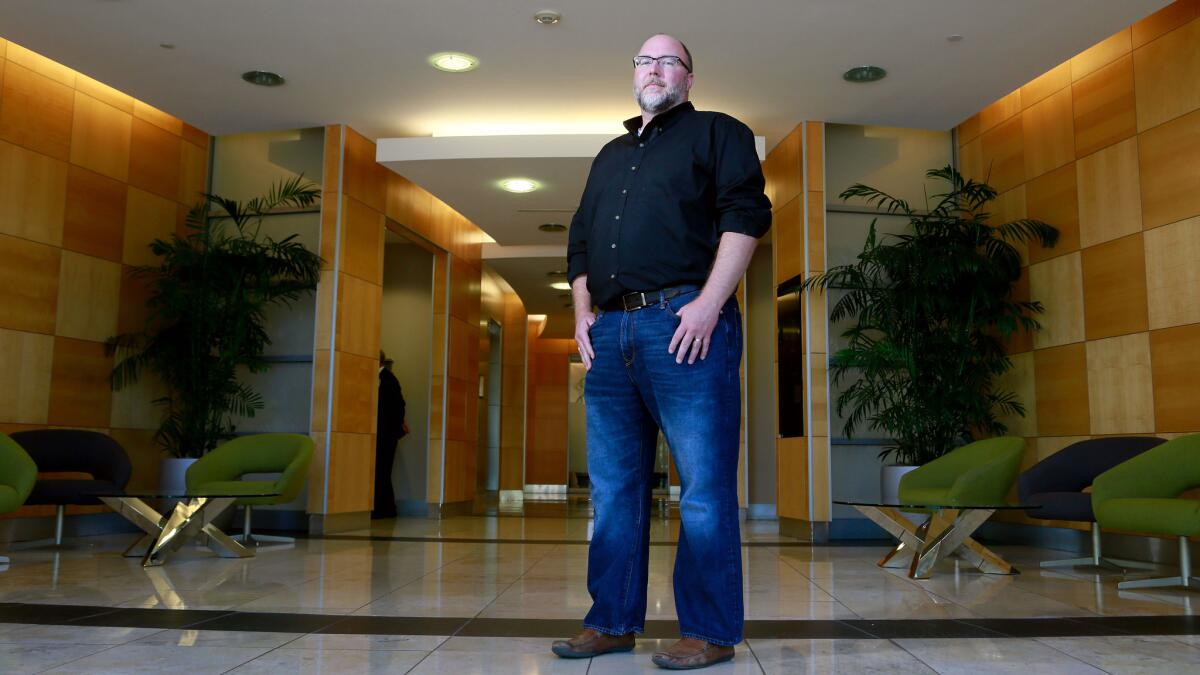Offer payday loans as an employee benefit, this start-up says

- Share via
For the past year and a half, Doug Farry has met with city councils, chambers of commerce and corporate human resources managers, telling a hard truth: Many workers live paycheck to paycheck and sometimes turn to payday lenders to get by.
He’s not trying to shame employers into boosting wages. Rather, he’s trying to convince them to sign up with his company, Employee Loan Solutions, a San Diego start-up that works with a Minnesota bank to offer short-term loans – ones that carry a high interest rate but are still cheaper than typical payday loans.
Some employers already know their workers can come up short and from time to time lend cash or advance paychecks. But for others, he said, it’s something they’ve never considered.
“There’s a misperception among some business leaders that this is somehow a problem of the unemployed or homeless,” said Farry, one of Employee Loan Solutions’ founders. “If you’re a CEO, making a seven-figure salary, this concept may not register with you.”
Employee Loan’s program, called TrueConnect, enables workers at participating employers to apply online and get a loan of $1,000 to $3,000. The loans are approved or denied almost instantly and are available even to borrowers with terrible credit.

The company, which began operations in 2013, is one of several offering lending programs as add ons to employee benefits packages.
Other firms, such as San Francisco’s Ziero and New York’s Kashable, have different business models – at Ziero, for instance, borrowers pay no interest, but participating employers pay a fee – but they all operate on basically the same premise: Employers are uniquely positioned to help workers find more affordable credit.
That there are multiple firms in the market illustrates the size of the opportunity and the dire financial straits many workers experience. An estimated 12 million Americans use payday loans, borrowing tens of billions of dollars annually.
The loans have drawn the attention of consumer advocacy groups and the federal Consumer Financial Protection Bureau, which have called payday and other high-interest loans debt traps. The CFPB this month released proposed rules that would rein in the lenders, requiring more underwriting to ensure borrowers don’t stay indebted for months at a time.
Employee Loan has structured its products so that they shouldn’t be affected by the new rules, which would apply to loans with interest rates of 36% or higher or that must be repaid in less than two months. All loans arranged by Employee Loan Solutions charge an annual rate of 24.9% and can be repaid over the course of a year.
Farry said his company is able to offer a lower interest rate and still make the product available to employees with even bad credit because of a lower cost structure.
For instance, because the loans are offered as an employee benefit, advertising is essentially handled by a participating employer’s human resources department. Payments are taken directly out of employees’ paychecks, cutting down on payment collection and processing costs.
Sunrise Banks, the St. Paul institution funding the loans, was the first company to offer TrueConnect loans to its own employees. It conducted a yearlong trial starting in late 2013 at the request of federal bank regulators, who ultimately approved the program.
Though the bank was keen on participating, its executives weren’t convinced any of their employees would need an emergency loan.
“Like any employer, we think we pay our employees well, so why would they need this product?” said bank President Nichol Beckstrand. “What we found is a lot of people need it.”
Over the first year, nearly one-quarter of Sunrise employees, including some of the bank’s bigger earners, took out a loan, she said. One worker even used a loan to buy lumber for a new deck, she said.
So far, a few dozen other employers have signed up with Employee Loan Solutions. Many are public agencies, which make attractive targets for the company because they tend to have stable, long-term employees.
The city of Anaheim offers it to municipal workers, as does Eastern Municipal Water District, a water agency serving parts of Riverside and San Diego counties, and the city of Cuyahoga Falls, a suburb of Akron, Ohio.
There are private-sector employers, too. Martin Gilberstadt, business development manager at Los Alamitos payroll firm TelePayroll, said his company plans to start offering TrueConnect loans to employees in the next few weeks – and as an option for its payroll customers sometime in the next few months.
“We’ve had employees who would come to us and ask for an advance on their salary,” Gilberstadt said. “The owner doesn’t want to get into their financial lives, and the employees don’t want to go to the CEO asking for an advance.”
Although TrueConnect’s loan terms are better than what’s available at most payday lenders, the loans don’t come with the kind of underwriting some consumer advocates would like to see.
The Center for Responsible Lending, among other groups, believes lenders should determine a borrower’s ability to repay any loan, and these loans should not be an exception, said Graciela Aponte-Diaz, the group’s policy director for California.
Even with TrueConnect’s relatively low rates and its pledge to limit loan payments to no more than 8% of a borrower’s paycheck, payments could still prove unaffordable if borrowers have too much other debt, high rent or other obligations, she said.
“You should have to show your income, your housing costs and what’s on your credit report,” Aponte-Diaz said. “There’s a lack of strong underwriting.”
Farry said that making such checks would make employees – even ones who can afford the payments – less likely to take out these loans and more likely to turn to a payday lender. He argues that borrowers see quick underwriting and the lack of a credit check as benefits, not downsides, of the payday lending industry.
“It has to meet the needs of the borrower,” he said. “We’ve talked to borrowers, and what they say is, ‘We need to know quickly. If I need to wait two weeks for an underwriting decision, I’m screwed.’”
What’s more, additional underwriting would cut into the already skinny profit margins of small loans. A $1,000 loan with a 24.9% interest rate paid off over one year generates only about $130 in interest, out of which servicing and other expenses must be paid before any profits are generated.
Currently, underwriting costs are kept low through an automated process with simple criteria. Employee Loan checks to make sure potential borrowers have been employed with their current employer for at least six months and caps all loans at 8% of annual pay – a figure aimed at ensuring the loans are affordable.
“We’re trying to squeeze out the costs of making these loans,” Farry said.
Joide Macey, for one, is thankful she was able to get a TrueConnect loan.
Not long after her husband left her, Macey, 50, borrowed $1,500 to cover rent, groceries and other necessities at an interest rate of 150%. The lender demanded the title of her 10-year-old Subaru Tribeca as collateral.
It was a desperate move that helped her out of a short-term jam but that soon turned into a long-term struggle.
For seven months, Macey struggled to make minimum monthly payments, though the balance of the loan never seemed to budge. She feared the lender would soon take her car, which she needs for work.
“I thought they would come in the middle of the night,” she said. “Those loans, they consume you.”
In January, her employer, an in-home care provider, added TrueConnect to its employee benefits. Macey borrowed another $1,500, most of the amount she needed to finally pay off her title loan.
Now, instead of paying $225 a month and not knowing when she’d ever be out of debt, she pays about $130 a month and knows that she’ll make her final payment in January.
“I don’t have that stress anymore,” she said. “It was the best thing I ever did. The best by far.”
Follow me: @jrkoren
More to Read
Inside the business of entertainment
The Wide Shot brings you news, analysis and insights on everything from streaming wars to production — and what it all means for the future.
You may occasionally receive promotional content from the Los Angeles Times.











